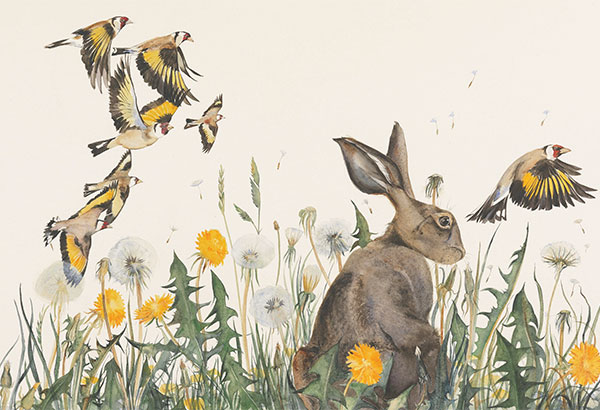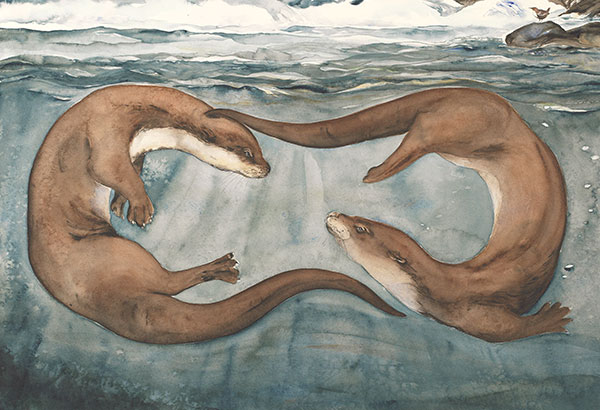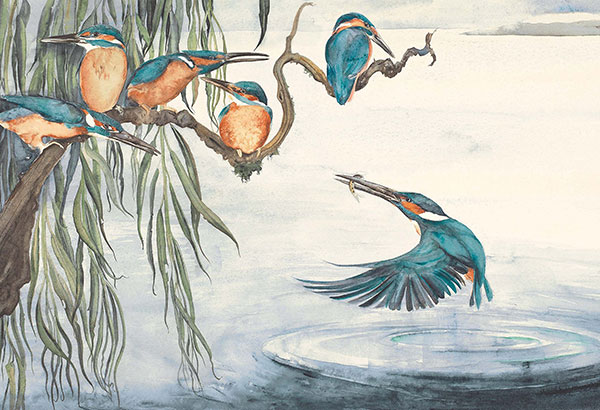Subtotal: $
Checkout-

The Children of Pyongyang
-

Cancilde and Emmanuel
-

Michael and Margaretha Sattler
-

The Pen and the Keyboard
-

My Fearless Future
-

Covering the Cover: School for Life
-

The Community of Education
-

Family and Friends: Issue 19
-

Verena Arnold
-

Tundra Swans
-

What’s the Good of a School?
-

On Praying for Your Children
-

The World Is Your Classroom
-

The Good Reader
-

Kindergarten
-

Should Christians Abandon Public Schools?

For everything you bring into your house, take something out. Who hasn’t encountered, by now, some version of this useful de-cluttering principle? But imagine applying it to more than clothes and knickknacks. Imagine it as a rule for language, so that every time you added a word to your vocabulary – selfie, say, or subtweet – you had to remove an older word to make room for it.
The Lost Words, a stunning new poetry picture book by Robert Macfarlane and Jackie Morris, responds to this very situation. In the latest edition of the Oxford Junior Dictionary, a standard primary-school reference text, new coinages like blog and voicemail have forced the exclusion – no doubt because paper costs money, and school dictionaries shouldn’t weigh more than the children who use them – of a whole body of words that evoke the natural world.

Jackie Morris, Dandelion, from The Lost Words
Presumably the dictionary is designed to reflect current usage among children, and presumably today’s children are talking more about the internet than they are about the woods. But I wonder which comes first: the actual extinction of words, or their removal from view, so that people who might have used them, or at least wondered about them, don’t? Perhaps the chicken-egg answer doesn’t matter nearly as much as what we stand to lose. If we lack the language to name for ourselves the realities that surround us, what does that do to our perception of them?
The fading of nature words – acorn, bluebell, dandelion, heron, otter, wren – from the active language of children strikes me as a kind of poverty. Too often, of course, this poverty intersects with material poverty. An art-teacher friend once described for me a class she taught in an inner-city public high school, in the course of which she was trying to explain what texture meant. “Like bark,” she told them. They looked at her. “You know,” she said. “The bark on a tree? Its skin?” Thirty pairs of teenaged eyes returned to her the flat gaze of total incomprehension. Trees had skin? Who knew? Who cared?
Which comes first: the actual extinction of words, or their removal from view?
“Well, what was I going to do?” she said to me later. “I made them get up out of those chairs, moaning and groaning, and we went outside, and we spent the rest of the hour touching trees.” Note, by the way, that there were trees in those students’ immediate environment. Some urban landscapes are, I know, concrete deserts, but in even the lowest-income neighborhoods in this particular Southern city where my friend and I then lived, trees grow thickly, profusely, lushly, but apparently – to children who have never been called on to notice them – invisibly.
As far as my friend’s students were concerned, bark was what dogs did, and that was that. Lacking language, they lacked access to real and imaginative territory in their own world. This lack may be attributed, with some plausibility, to other lacks they experienced. But it is a lack not limited to situations of economic deprivation. Any child, anywhere, at any socio-economic level, may be vulnerable to the same poverty, the same blindness. All it takes is for some crucial adult in that child’s life to consider that dandelions, for example, are not worth the bother of naming.
In The Lost Words, Macfarlane and Morris aim to restore an imaginative vision of the natural world. Macfarlane might have contented himself with simply listing and defining those words lost to the dictionary, pairing them with Morris’s breathtaking illustrations. An illustrated nature dictionary would have been, in itself, a magical-enough book. But in making each “lost word” a poem, Macfarlane has revived not only the word itself, but language as an experience. The book’s subtitle labels it “A Spell Book,” and its poems are incantatory, each one a litany of reclamation.
Many of us may feel as numb to the declarative power of poetry as we are to the textured reality of nature.
As the American poet Dana Gioia has put it, this is poetry as enchantment. What does that mean? In his essay of that title, Gioia notes Robert Frost’s definition of poetry as a means of remembering, “which is to say a mnemonic technology to preserve human experience.” Frost, himself a dedicated chronicler of the natural world, maintained, as Gioia says, that the loss of what it preserves “would impoverish us.” This is to say that poetry enriches human consciousness or, at the very least, protects things of common value from depredation. Finally, he asserts that poetry guards against the human danger “to forget.” Here Frost acknowledges that the art opposes the natural forces of time, mortality, and oblivion, which humanity must face to discover and preserve its meaning. As Frost said elsewhere, one of the essential tasks of poetry is to give us “a clarification of life … a momentary stay against confusion.”
Many of us may feel as numb to the declarative power of poetry as we are to the textured reality of nature. For instance, we might have had Frost’s “Stopping by Woods on a Snowy Evening” explicated to us by our eleventh-grade English teacher as a poem about suicidal ideation, full stop, because the woods are dark and cold like death, and snow is white, which is a color symbolically associated with death. If this has been our experience, then it’s understandable that we might struggle to see the forest for the death wish. Meanwhile, the poem’s undeniable music – “… the sweep / Of easy wind and downy flake” – goes unheard. It is precisely this music that generates the “mnemonic technology” Dana Gioia describes. While it might be entertaining to speculate about the poem’s darker meanings, the memorable experience of it is far more immediate and physical than any abstruse speculations. Its patterns of meter and rhyme make it an easy poem to memorize, a deeply pleasurable poem to recite aloud. And if we should find ourselves in the woods on a snowy night, then we have something to say about that: “the woods are lovely, dark, and deep.” In saying it, letting the alliteration roll off the tongue, we know something. We see it. It exists for us.

Jackie Morris, Otters, from The Lost Words
This same “mnemonic technology” is at work in The Lost Words. The poems in this book are acrostics: each letter of a “lost word” begins a poetic line. The effect is one of opening-out, the word expanding to contain an entire linguistic ecosystem. Take, for example, the first two lines of “otter:”
Otter enters river without falter – what a
supple slider out of holt and into water!
This shape-shifter’s a sheer breath-taker, a
sure heart-stopper – but you’ll only ever
spot a shadow-flutter, bubble-skein, and
never (almost never) actual otter.
In this poem, each line moves from internal rhyme to internal rhyme. In the first line, the feminine rhymes of otter, falter, water, plus the additional, masculine-rhymed river and slider, establish a pattern that suffuses the whole poem with forward movement. The reading ear alerts itself continually to the next instance of rhyme, slipping forward through the lines even as the otter slips down the bank and into the water. Too, in its persistent alliteration and its repetition of hyphenated names – shape-shifter, breath-taker, heart-stopper, shadow-flutter, bubble-skein, silver-miner, inside-outer – the poem echoes the Anglo-Saxon poetic line, held together by its emphatic consonants and illuminated by its kennings. This resonance suggests another recovery from extinction by amnesia, that of the English poetic tradition itself. Meanwhile, where the lines run on, visually, as if they were prose, these devices sustain the necessary tension and density that mark what looks like a paragraph as not a paragraph, but a line of poetry, in simultaneous conversation with its subject and its tradition.
Similar phenomena occur throughout the book. “Here hunts heron. Here haunts heron,” begins the poem about that leggy water bird, its alliterative stresses hammered home. But note the sleight-of-hand that also occurs in this line. Slip in one letter, and hunt becomes haunt. Nature opens into the supernatural: bird becomes spirit, though the next line transfigures him again into something mechanical: the “huge-hinged heron.” Again and again, the poems enact these incantations. In an instance of levity, they conjure the newt:
“Newt, oh newt, you are too cute!”
Emoted the coot to the too-cute newt
“With your frilly back and your shiny suit and your spotted skin so unhirsute!”
The newt poem calls up the rhyme-patterns of rap, with its constant and surprising experimentations in sound. And the fern poem summons the ghost of Robert Frost. Its trimeter opening line, “Fern’s first frond is furled,” echoes Frost’s “Nature’s first green is gold,” even in the palimpsest of an end-rhyme. If these are poems about natural history, they are also poems about the natural history of poetry itself. They invite the reader to a sharpened vision of the natural world, but they also extend an invitation to savor the English language as its own fascinating and accessible ecosystem.
We too often underestimate children, at least if our television programming for them is any indication.
I marvel at this book for its own virtues, but I also marvel that a book like this was created for children. We too often underestimate children, at least if our television programming for them is any indication. Even those earnest public-television children’s shows on whose ancestors I grew up, and which my own children watched, subscribe heavily to the theme of Reading Is Good, and If You Watch This Half-Hour Program, You’ll Know Why. Meanwhile, many children’s books seem to assume that children occupy some lower rung of the evolutionary ladder where the apogee of cultural expression is the fart joke.

Jackie Morris, Kingfishers, from The Lost Words
While I can think of beautiful, poetic, nature-themed picture books for children – Jane Yolen’s Owl Moon, for example – it is harder to call to mind books of poetry for children that show the same intelligence and attention to craft which their authors bring to bear in their work for adults. In this slender category I would include Richard Wilbur’s hilarious Opposites, and the children’s poems of the Cornish poet Charles Causley, between whose writing for adults and whose writing for children the line is very fine indeed. Like Causley, who could write a comic poem beginning, “The Reverend Rundle, his gear in a bundle,” and then shift in an instant to the hauntingly elegiac – “‘Love is not here,’ the hawthorn said” – Macfarlane presumes the child’s capacity for a whole range of human emotion, all predicated on wonder, as well as the child’s ability to follow and thrill to the complex play of the English language.
The child who reads this book may, I hope, become an adult who still marvels at the crushed sunlit scent of a dandelion. More than that, I think it’s reasonable to hope that the same child, grown to adulthood, might experience poetry, too – not as alien, uninviting, or simply beneath notice, but as a world in which he or she is instinctively at home and alive. In what might be called our post-enchantment age, it is remarkable to encounter a book that offers, without irony and with high seriousness, the dual enchantments of nature and poetry.
Already a subscriber? Sign in
Try 3 months of unlimited access. Start your FREE TRIAL today. Cancel anytime.



























Marcia
Can’t wait to read this book!
Erin Kahn
This is such a beautiful review of what I can only imagine is a beautiful book. Thank you for sharing your thoughts (so eloquently, too!). And I agree, we underestimate children far too often. I remember reading an illustrated children's book of Emily Dickinson poems as a child and falling in love with poetry for the first time. And like Rebecca, I was always a fan of the Flower Fairy books.
Rebecca Pettigrew
Thank you for this. I can’t wait to purchase the book! I might add that Cicely Mary Barker’s Flower Fairy books are noteworthy in similar ways. My children and I loved to recite them and to find and name the different flowers she celebrates in poetry and drawings. She helped me raise children who “notice” the natural world. Just the other day my teenaged son exited the house in a huff, being a tad late for school, but he still stopped on the doorstep going out and gasped, taking in a lavender sunrise; he even snapped a photo on his phone before rushing off to the noise and rush of daily obligations.